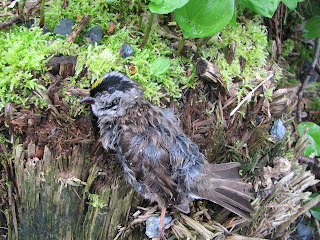Shrews are the smallest of the mammals. They are often mistaken for mice but are insectivores, not rodents. They are found throughout Alaska, even on some isolated islands. Shrews are found everywhere except Greenland, Australia, southern South American and some Pacific islands.
Shrews are small, ranging in size from 74-158 mm (3-6.5 inches) total length. Their tails are typically from one-quarter to one-half of their length. They weigh from 1.5-20 grams (a penny weighs 3 grams). Most are a grayish-brown coloration with a paler colored belly. Shrews are short-legged and have a long pointed nose with long whiskers. Their teeth are tiny, white with reddish-brown tips, but sharp for attacking and eating prey. Their tails are hairy in young shrews but usually naked in old adults. Their eyes are tiny and vision is poor, but they have acute senses of smell and hearing.
Shrews are solitary except when breeding, mainly terrestrial, and live under the grass and leaf litter. They are active throughout the year and burrow through the snow during the winter. Most shrews prefer moist habitats, and the water shrew is often found in streams, ponds, and marshes.
The breeding season is from March to August. Two to 10 young are born after a 17 to 28 day gestation period. The young are born naked and blind in a nest of grass. The young are weaned after 3 weeks. Females generally have several litters per year. Shrews live from 12 to 18 months.
Wednesday, May 25, 2011
Sunday, May 22, 2011
Savannah Sparrow
Good morning Jess (though next time Alva, I'll just take a coffee in bed) can you figure out where I found this bird this morning?
The Savannah sparrow is found in temperate coastlines to tundra and has 17 recognized subspecies.
Savannah Sparrow is a small songbird (4.3–5.9 in) with brown or grayish-brown overall. It has streaking on back, breast, and flanks with a yellowish eyebrow stripe (see above). Distinctive stripe down center of crown (see above) Dark line extending from back of each eye and from base of bill to back of head. Small bill. Often runs on the ground like a small mouse. Silly bird.
Clutch size ranges from 2-6 eggs which are pale greenish, bluish tan or even white with speckles and streaks. Color varies widely even within population and sometimes even within clutches.
The Savannah sparrow is found in temperate coastlines to tundra and has 17 recognized subspecies.
Savannah Sparrow is a small songbird (4.3–5.9 in) with brown or grayish-brown overall. It has streaking on back, breast, and flanks with a yellowish eyebrow stripe (see above). Distinctive stripe down center of crown (see above) Dark line extending from back of each eye and from base of bill to back of head. Small bill. Often runs on the ground like a small mouse. Silly bird.
Clutch size ranges from 2-6 eggs which are pale greenish, bluish tan or even white with speckles and streaks. Color varies widely even within population and sometimes even within clutches.
Thursday, May 12, 2011
Golden Crowned Sparrow
I was walking into the yurt with Andrew Kirby and we were talking about my bad cats and how he doesn't like that they kill things when Sancho comes out of the door with tail feathers and two legs sticking out of his mouth. Busted! Even the dog is into birding now. Yellow crown sparrow, bordered by black with a gray face and chest. It has white wingbars, back brown with black stripes and a long tail.

The Golden-crowned Sparrow pecks and scratches at the ground to forage, occasionally picking at foliage or jumping into the air after an item. Paired males and females forage together, typically with male following female. The species flies with fast wingbeats when crossing between patches of cover, but often drops to ground and runs for cover when alarmed. While not foraging, this sparrow can be seen perching on the tops
of trees or shrubs. -
Note the tail feathers by Alva's whiskers. Very interested pets.
Thursday, May 5, 2011
Fox Sparrow
I walked into the yurt with Liz Ford and we were discussing how the cats haven't killed anything for a few months when we looked down and discovered that there were feathers everywhere! A fox Sparrow's feathers. This fox sparrow was much darker brown/black then the last fox sparrow which was reddish brown but both were about 7''.
Fox sparrows are heavily spotted to streaked on their chest region and I found out that have a spot on their chest where all the spots come together and make a bigger "messier spot".
A similar species the song sparrow has an all dark bill, notice the fox has a light lower mandible.
Fox sparrows are heavily spotted to streaked on their chest region and I found out that have a spot on their chest where all the spots come together and make a bigger "messier spot".
A similar species the song sparrow has an all dark bill, notice the fox has a light lower mandible.
Subscribe to:
Comments (Atom)







